The V8 – the MG with effortless performance
Launched in August 1973, the V8 powered MGBGT combined the popular fixed head coupe body style with a powerful three and half litre light alloy V8 engine. The Rover powerplant ran with a reduced compression ratio but an increased torque compared with the similar engines then used in the Rover saloons. The result transformed the MGB, creating a very nimble car with the luxury of multi-cylinder power which was both flexible and economical – features which continue to have a special appeal for V8 enthusiasts today.
On the road the V8 has an effortless performance, accelerating rapidly in the higher gears between 50 and 70mph. One of the road tests in 1973 recorded 127 mph available in both direct and overdrive top. Hills just melt away and the torque gives the car an unfussy manner. The 0 to 60 time of 7.7 seconds is still, some 35 years later, a time many of today’s sports saloons cannot touch. Even when asked to work hard, the exhaust note retains its very pleasingly modest but purposeful burble, in keeping with the V8’s understated manner.
The V8 engine, although from an old Buick design in the early fifties, contains hydraulic cam followers which give the V8 a quietness that complements the smooth power. Under the bonnet, the lightweight aluminium V8 engine is much bigger than the original four cylinder cast iron engine but is only just a little heavier when the engine ancillaries are included. Those lightweight benefits give good front to rear weight distribution and there is an appreciable increase in the power to weight ratio, even from the detuned 137 bhp V8 engine.
A surprising feature of the V8 is the fuel economy. Even driven on the open road with a sense of fun, it is quite easy to achieve between 27 and 29 miles to the gallon and more. The overdrive unit gives the V8 long legs with around 28 mph per 1,000 rpm or 3,200 rpm at 90 mph. The convenient overdrive facility is available on top gear at the flick of a stalk switch on the steering column and on many of the earlier chrome bumpered cars it is available on third gear as well.
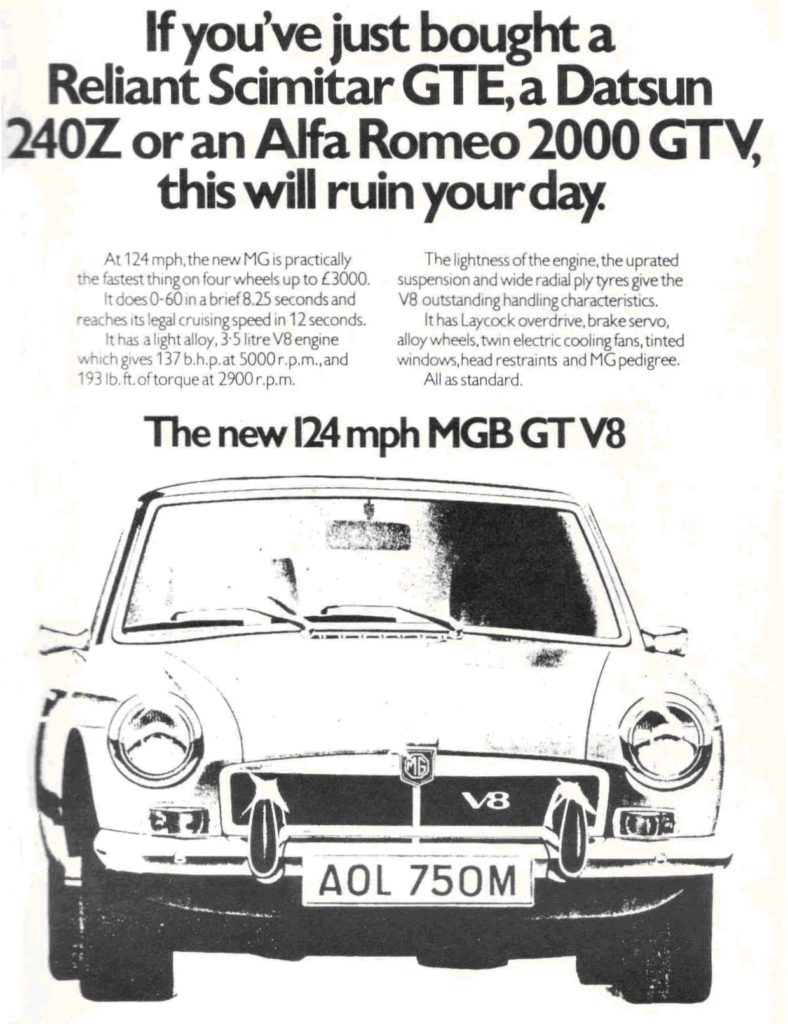
The V8 is however not without its poor features – excessive wind noise at speed and a choppy ride at slow speeds from the stiffer rear springs which are needed to cope with the higher power output. Keeping the machine cooled in traffic with an undersized radiator needs an artificial gale from twin cooling fans. The gearbox has to be treated with consideration to avoid costly repairs so most V8 enthusiasts develop a smooth style of driving using the V8 power and torque. There is simply no need to race up and down the gearbox punching the additional power through to the road wheels.
At its launch in 1973, the V8 was welcomed as a powerful example of the MG marque but was generally regarded by the motoring press as arriving several years late in a popular but ageing bodyshell and suspension package, then over ten years old. The specification of servo assisted brakes, distinctive light alloy wheels, tinted glass, fine cord covered adjustable seats, head restraints, two speed wipers and an overdrive as standard made it a refined sports car for 1973 and good value at its launch price of £2,294.
Three litre straight six rivals in the marketplace like the TVR 300M and Datsun 240Z were £170 to £400 more and if you felt a three litre V8 Triumph Stag convertible was a rival, then that was £324 more. Even where buyers were attracted by the MG heritage there was an inevitable comparison with the reduced spec four cylinder MGBGT then on offer for only £1,575. But economic factors were also to play a part in how sales of the new model faired because in late 1973 and early 1974 there were Middle Eastern tensions from the Arab-Israeli war and the consequent concerns over fuel prices certainly made large engined cars look an uneconomic choice.
As stocks of V8s were dispatched to distributors around the UK, inflation picked up too with rising retail prices depressing the marketplace, so many V8s stuck in showrooms for many months. Then prices of new cars began rising rapidly so during 1974 a V8 rose by just over 20% to £2,800 and by autumn 1975 to £3,372. In October 1974 the rubber bumpered models began to be dispatched from Abingdon but by July 1976 it was all over – sadly production had ended, except for a very few vehicles rolled out over the next few months with the facelift bodyshell and “deckchair” seats.
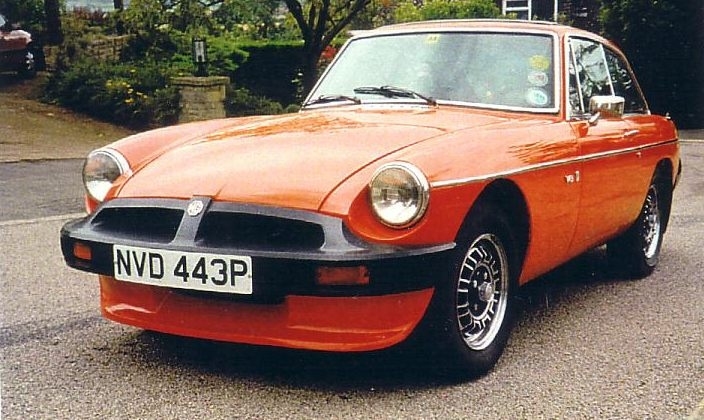
Although a few of the early V8s were built in lefthand drive for the mainland European market, BL never made sufficient funds available for MG to clean up the engine and make the other conformity modifications necessary to get the car into the USA. Surely that was a market that would have welcomed an MG with a big V8 engine! So the relatively modest output of the V8 model was officially reported as 2,591 of which some 1,862 (72%) were chrome bumper cars. That was less than a third of the three litre MGC output for example but despite that relative rarity, the V8 has largely remained an undiscovered classic sportscar over the years because for many people there appears so little to distinguish the V8 from a standard four cylinder model. The reality is quite different – it is not until you first drive a V8 that you realise what a total transformation V8 power provides.
Prices of V8s have remained fairly steady for many years and it seems two factors may have been at play. First a high proportion of owners have had their V8s for many years with relatively few coming up for sale and second the model has been overlooked by “chequebook investors” so prices have never been driven up, even in the heady days of the 1980s and 90s. The V8s that have come up for sale over the last few years have attracted interest from a new wave of enthusiasts who recognise what exceptional value the V8 is in every sense.
New owners often comment on registering their car that the wealth of technical support and information on the model available on the V8 Register website had stimulated their interest and helped them gain an informed awareness of the car. They also note they were attracted by the Club’s very successful register based group of enthusiasts providing a range of well developed technical support and website services. The active “V8s for Sale” webpages have become the leading place to buy and sell a V8.
So if you are thinking of getting a V8, what do you need to know about the model and look for when you inspect a car for sale? Well with the outline of the model above, this note aims to provide you with a concise briefing highlighting the key areas of concern you will need to check out. Of course you will also need to make the prudent checks you should make when buying any car.
What to look for
With any classic car the condition of the bodyshell is a key area of concern as the cost of bodywork refurbishment can be a serious outlay and where more substantial restoration is necessary, the cost can often exceed the value of the restored car. This is a particular concern with an MGB or a derivative like the V8 which has one of the original steel monocoque bodyshells with the minimal rustproofing provided in the early 1970s. Fortunately replacement bodyshells are readily available today from the British Motor Heritage Body Plant at Witney in Oxfordshire with much improved anti-rust treatment, so they should suffer far less rust attack. Whilst those shells are reasonably priced, having a V8 rebodied is a costly and time consuming exercise.
So inevitably examining the bodywork of a V8 will be your first check as a prospective purchaser. Of course the mechanicals and interior trim are important too, but if the bodywork is in need of attention you will need to assess the extent and cost of any works necessary to bring the car up to the standard you aim to have and then consider whether the purchase would make financial sense for you.
MGBV8 conversions in either GT or Roadster form are also available from time to time but the specification and build quality vary a very great deal. The earliest conversions were produced by Ken Costello based on an MGB 1800 and were well finished but are inevitably up to five years older than some Factory V8s. Many more conversions have since been built by enthusiasts and by MG specialists to meet client orders.
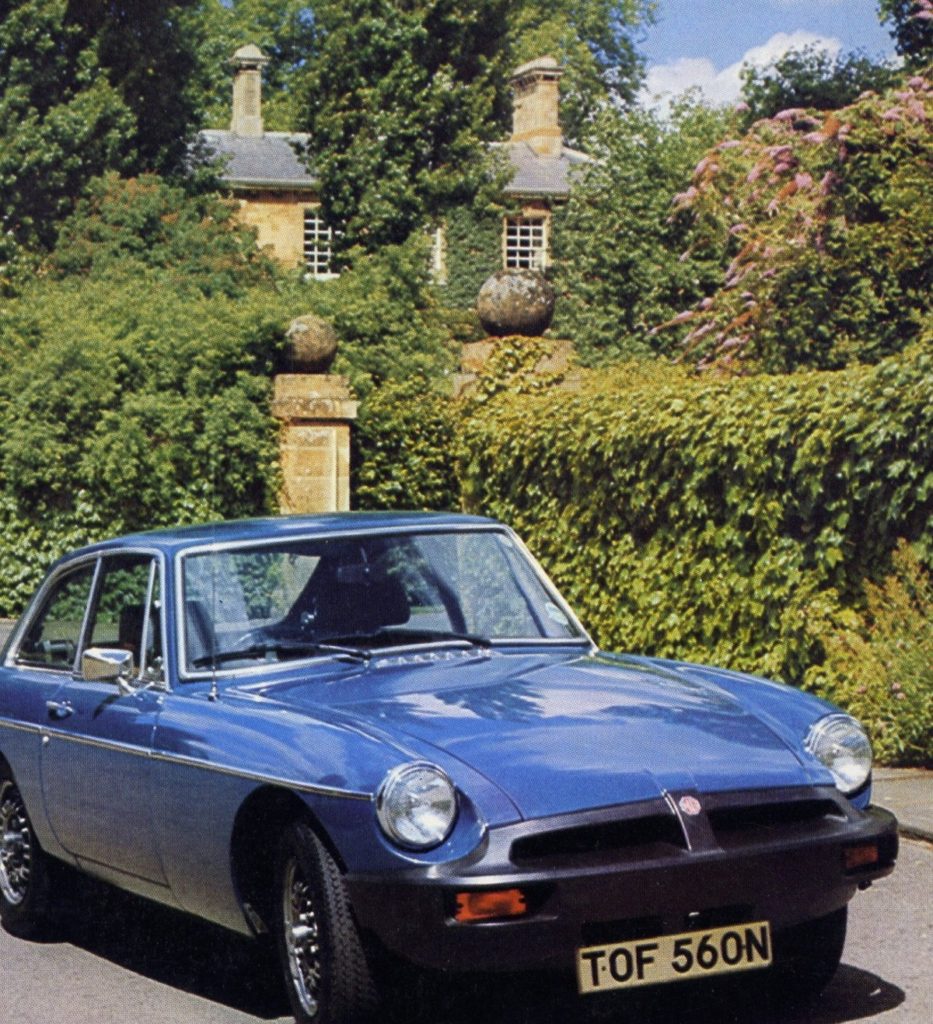
Most have been V8 Roadster conversions, particularly since the BMH Body Plant began producing an MGB Roadster bodyshell for a V8 conversion. Some really beautiful V8 Roadsters have been built but are inevitably bespoke in terms of specification and finish. But the main concern is the quality of the conversion and to assess that most buyers will need specialist help. So that is outside the scope of this guide, but Roger Williams’ book “How to give your MGB V8 power” is an authoritative and indispensable reference source for anyone considering a V8 conversion.
Bodywork and exterior
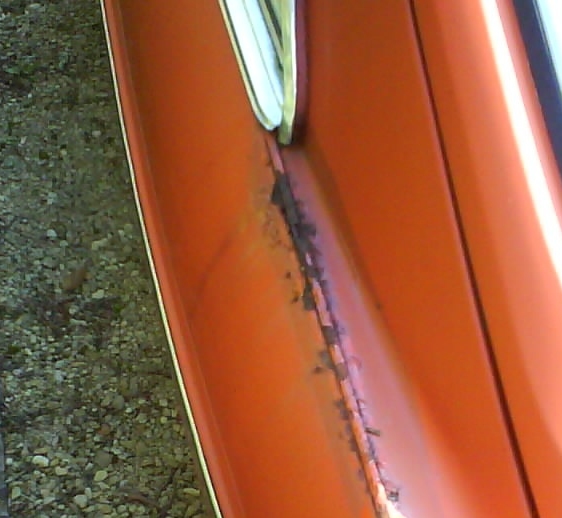
Rust well established on the rear wing seam 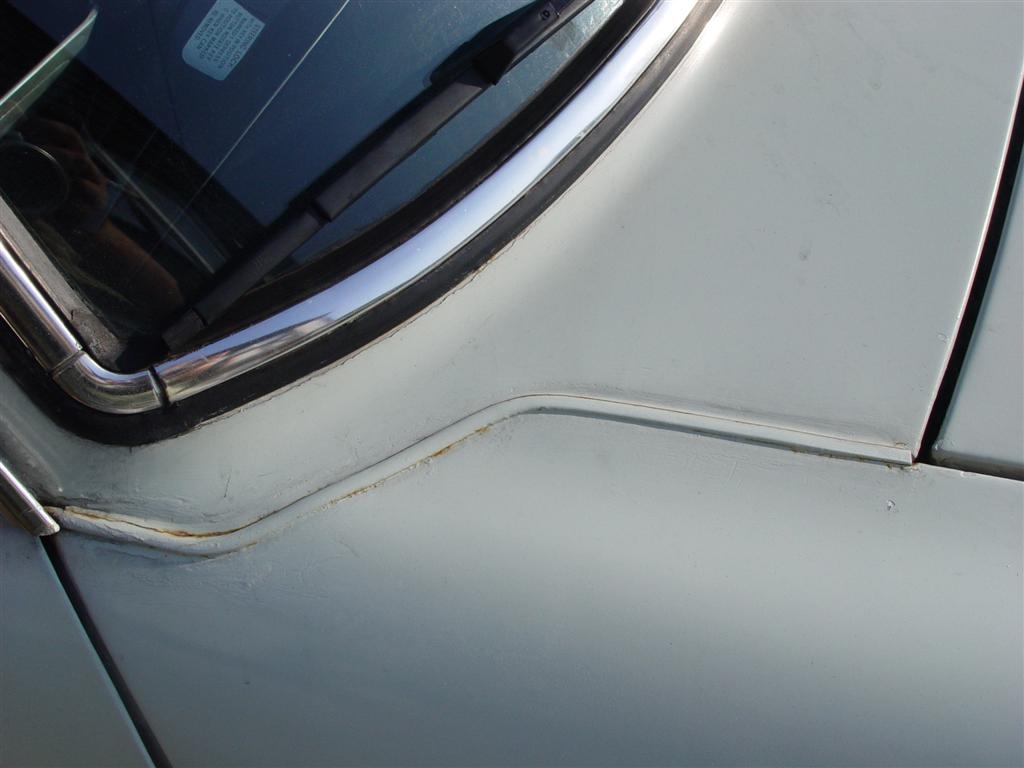
Rust emerging on the front wing dog-leg seam 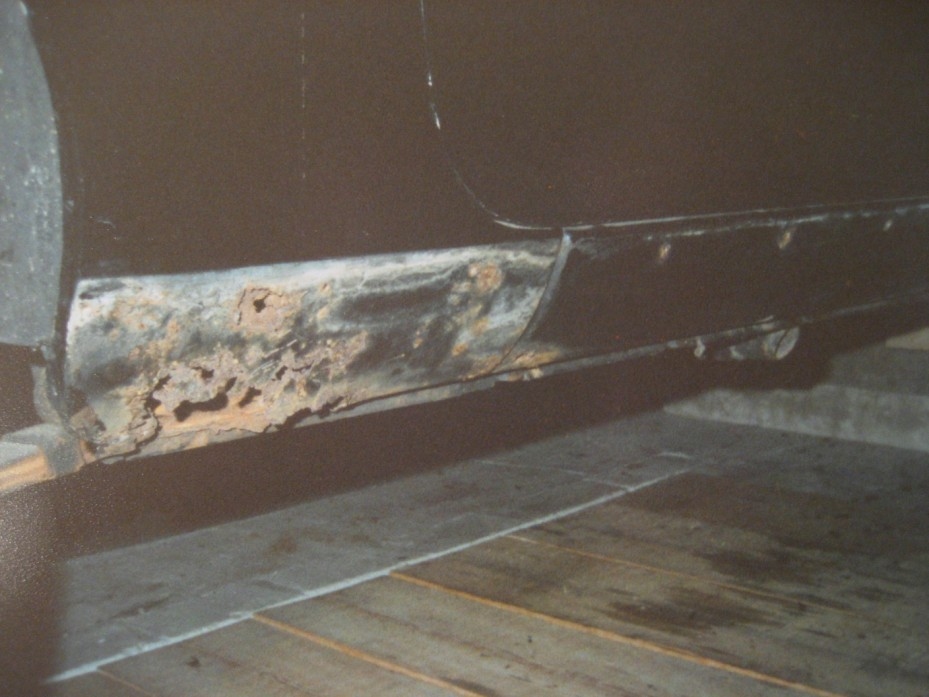
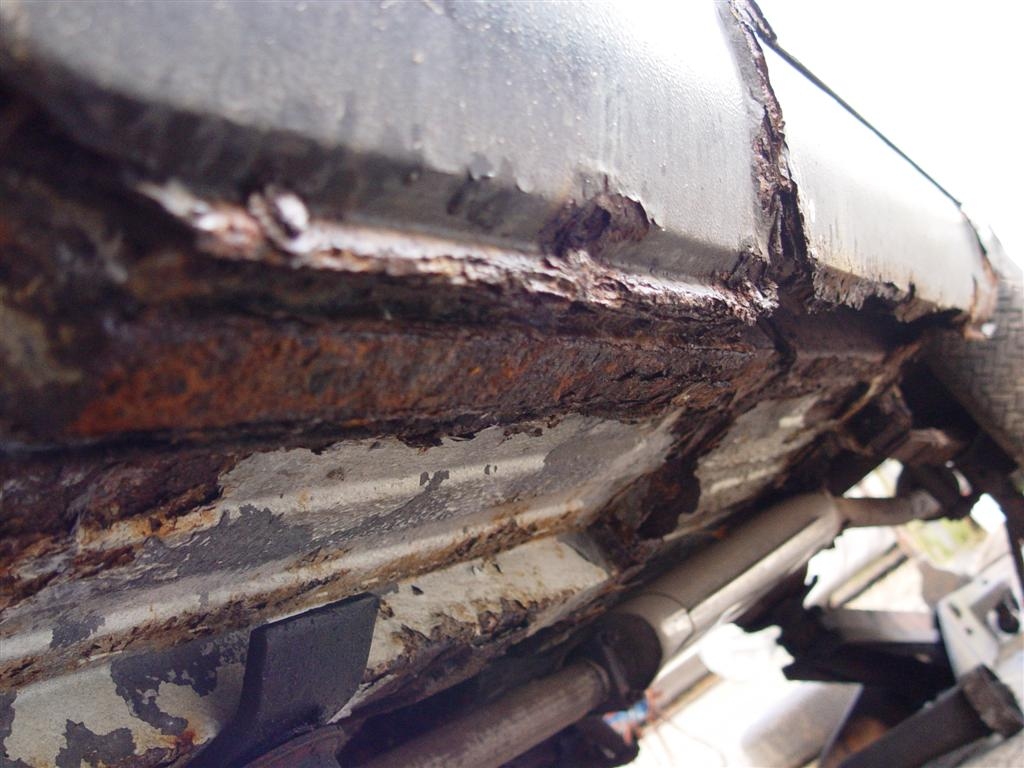
Two examples of rust in the sills and lower rear wing – an area prone to rust.
After some 35 years or so, very few V8s will have survived without at least some refurbishment and many will have undergone more serious restoration. So if it’s a Factory V8 you wish to get, then the reality is there are very few left in a decent condition that have not been altered in some way. But even if you do come across an example which is described as ”totally original” you will need to check whether “totally original” means the bodywork and paint finish are just as they left the factory with only the inevitable wear of the subsequent years, or has the car had necessary refurbishment or restoration at various times but in a way which has maintained the original qualities of the car?
There are some genuinely original cars around, full of Waxoyl, rarely driven in conditions when salt is on the road and are kept in good garaged conditions. There are many more you would consider “original” in the sense that they have been well maintained with anti-rust treatment and timely refurbishment. But there is also an increasing number of V8s becoming available with what may at best be described as “tired bodywork”. They are on offer at modest to medium prices. It is these cars a prospective purchaser will need to take great care over, unless you are looking for a V8 simply for short term use.
Sadly with really rough cars, their residual value broken for spares is likely to be greater than the value as a restoration project. Consequently we are likely to see increased numbers of Factory V8s scrapped for spares over the next five years, but looking on the bright side that is likely to provide essential parts for the increasing number of V8 Roadster conversions.
As you approach a V8 for the first time check the modest V8 motif is located alongside the square BL badge on the nearside wing and another is fixed just above the nearside bottom edge of the tailgate. Often you see the V8 motif is repeated on the offside wing but this is not an original feature. This immediately suggests the car has had a respray and that either the owner at the time or the bodywork shop carrying out the work may have forgotten the V8 motif was originally fitted by the MG Plant only to the nearside wing.
Next you will need to examine the bodywork in detail. First look down the sides of the car to see if there are any signs of panel repair, then check panel fit and then make a thorough examination of the car, particularly the rust prone areas. The key areas to check for rust on a V8 or indeed any MGBGT are behind the headlights, the dog-leg seam on top of the front wings in front of the windscreen, the rear wing seams, on top of the ledge towards the rear of the inner wing and then the sills on either side.
You need to examine the sills with the thought in mind they are a major structural element linking the two ends of the car. So any serious corrosion here could become an MOT test issue and require skilled body shop work in fitting new sill components and carrying out the associated repairs. The danger point for rust is where the rear end of the sill blends into the rear wheel arch between the rear edge of the door opening and the front edge of the rear wheel arch. There is a particularly nasty pocket there almost an inch deep with an open end pointing down and back at 45 degrees.
Chrome or stainless steel oversills may be seen as an attractive additional feature by some enthusiasts but what is clear is they can hide some ugly corrosion in the sills (see example alongside) which might need prompt attention once discovered. So treat them with caution.
The seams on the top of the front wings ahead of the windscreen and the rear wing seams from the rear quarter-light to the tail light cluster are main areas for corrosion, particularly with cars that have spent a great deal of time parked out in damp weather. The paint along the seam can crack slightly and water tends to pool at both locations, so rust attack follows without good maintenance. The portion of the rear wing seam in the recess below the tapered end of the quarter light is another danger area for rust, so open up the rear tailgate and probe below the seam and quarter light amongst the foam filler inside the trim to see the extent to which water may be getting in at that point.
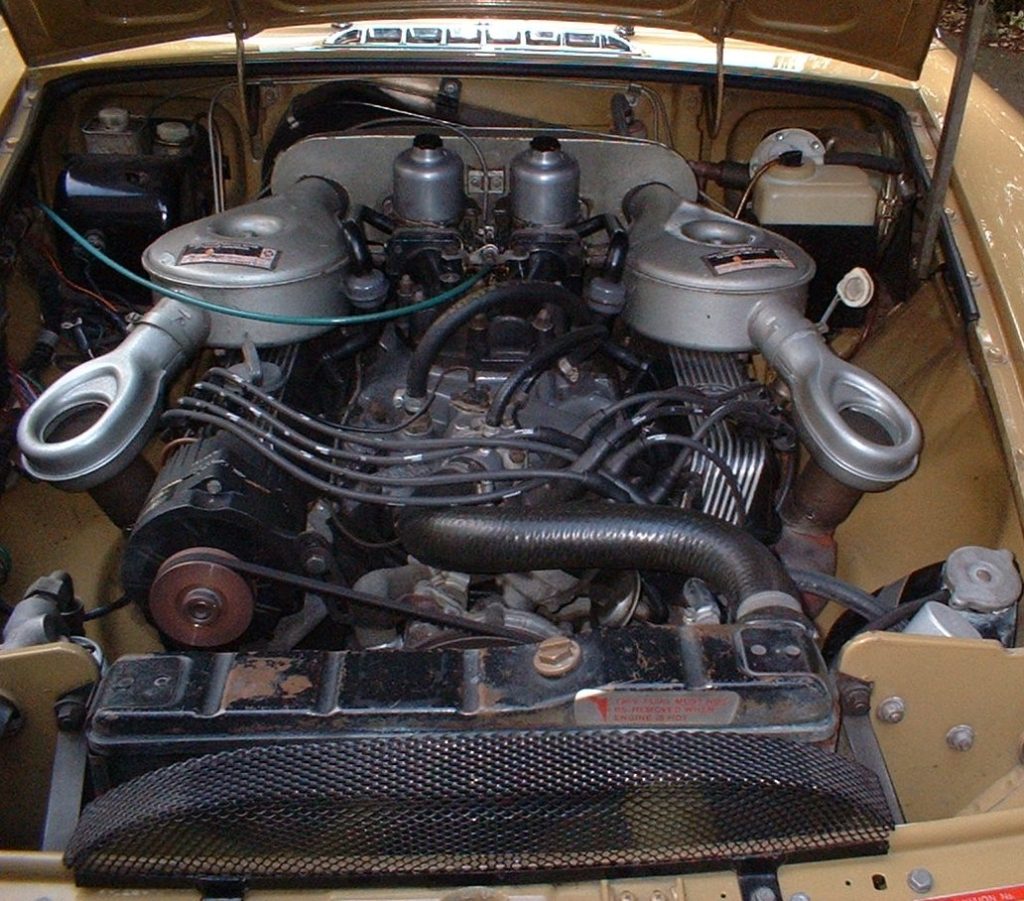
Engine and transmission
The V8 engine is an under stressed unit and a long life is usual provided the oil is changed regularly. The importance of regular oil changes with a V8 cannot be repeated too often because the engine lubrication system is a low pressure high volume system and the oil passageways serving the rocker shafts are prone to sludging up. This is made worse by dirty oil, so when you inspect a V8 pull out the dipstick on the nearside and check – it should be clean and usually a golden colour.
If it is black then that is not a good sign that the seller really appreciates the need for an oil change every 3,000 miles or at least annually. It would be worth checking the service records to see when the last oil change was recorded. If the owner does his own oil changes, just enquire whether it is necessary to change the compressible sump nut washer – the answer is yes it is necessary and most V8 enthusiasts will have several spare compressible washers in the central arm rest.
Whilst you have got your head in the engine bay, there is another check you can make which will give an indication of how aware the seller is of routine maintenance. Just unscrew the black plastic cap of each SU carburettor and see if the dampers are topped up with engine oil. With those dampers working well, the V8 is so much easier and smoother to drive and consequently more enjoyable. There may be no oil in the dampers which is not an encouraging sign.
Another more serious issue with the carburettors is the essential check whether the short rubber pipe between the two carburettors has been replaced recently because, exposed to a great deal of heat, it can fail without warning sending a pee-like jet of fuel over a hot engine. The ideal replacement is a metal braided pipe which has a longer life.
Yet another check in that area is on the air collector box – that is the box that bolts to the carburettors. On the rear face of the box there are two studs, one on the offside to which the choke cable clip is secured and one on the nearside which was provided to secure the choke cable on LHD cars. Back in the early 1980s there were a number of incidents where the nearside stud came lose and fell into the air box and found its way to the carburettor intake and on into the engine!
At one time the V8 Register supplied an “engine life saver kit” as a remedy for securing the unused stud on the air box – it comprised a nut and spring washer locked onto the exposed thread to prevent the stud falling into the intake. Most V8s have had this modification fitted but it is still worth checking.
The gearbox needs some care and respect for the relative fragility of first, reverse and second gear, or you may pay dearly. Original gearbox parts, in particular the laygear, are no longer available. The bearing recesses inside the gearbox cases can become oval and so no longer locate the gear-train correctly. Many cars now have a Rover 5 speed box as a replacement, usually from the SD1 Rover, which incorporates an oil pump and was specifically designed to cope with the torque of a V8 engine so is much more robust. The standard V8 clutch is also robust and will easily take more than 150,000 miles of road use. The same cannot be said for the clutch cylinder and its slave cylinder, but these are available and not too expensive to replace.
When you fire up a V8 from cold, particularly when it has not been run for a while, you will hear a clatter from the hydraulic cam followers or tappets as they pump up with oil. This noise will last a short while until the oil pumps round to the followers whereupon they should become quiet as the engine warms up. For those not familiar with the V8, the oil pressure gauge will provide a surprise – it should show 42psi rather than the 70psi you might see on an 1800 MGB and later, when the engine is hot and on idle at around 500 to 600rpm, you will see 20psi. Do not be alarmed as the V8 has a low pressure system.
Most V8s have been fitted with a stainless steel exhaust system as the mild steel units tend to rust out in a few years. The stainless systems last for years so are very good value for money. If you should get a system replaced by a fitter who is not a V8 specialist, then take very great care. The branches of the new system must be set exactly to fit the cast iron exhaust manifolds – any attempt to pull in the exhaust tubes to meet the manifolds runs the serious risk of cracking the cast iron manifold flanges. Far better to use a V8 specialist and avoid that risk and any subsequent hassle with cracked manifolds. Many V8s have tubular manifolds but take care as some are poor quality and make access to the manifold bolts very difficult.
Cooling is a major issue with V8s. The radiator is further forward than on an MGB and to fit under the bonnet without an MGC type of bulge, an undersized radiator was fitted by the Factory. To cool the car in slow moving traffic, the V8 has twin fans which come on with an audible roar as they generate a forced airflow through the radiator matrix. The V8 engine bay certainly can get very hot indeed and the temperature gauge reading can alarm drivers new to the model. There are many V8NOTES on this topic but for those unfamiliar with the V8 it is worth stressing it is essential not to overfill the radiator expansion tank – a quarter to a third full when cold is quite sufficient. With higher levels you run the risk of siphonage which only compounds the overheating problem. Also make sure the pressure cap has the correct pressure setting and is serviceable.
The fuel pump location in the rear offside wheel arch of many V8s is not ideal but switching to an electronic SU pump rather than the original SU with points can be a worthwhile modification with no external differences. For enthusiasts who lay up their V8s over winter the electronic pump avoids the need to tap the pump to free the points when it fails to operate after a prolonged spell of inactivity.
On a test drive you may hear a knocking sound on the steering column as the engine rocks at higher engine speeds. This is likely to be a sign that the engine mounts are tired and need replacing. Equally you may hear a pinking or light tapping sound from the engine bay at low engine speeds with the engine under load – that could be loose exhaust manifold nuts needing tightening. It’s not uncommon to hear a slight buzz or hiss from the gear stick too but that is normal.
The myth that overdrive on third was discontinued early in the V8 production run can be laid to rest. In fact some 60% or more of the chrome bumpered cars left the Factory with overdrive on both third and fourth gears. It is a very convenient feature which gives the model superb mid range flexibility, but using overdrive in third gear needs care as the overdrive unit can suffer damage from the high torque from the V8 engine.
Unlike many other cars fitted with overdrive since the 1970s, the overdrive switch on the V8 is not automatically overridden as you select a lower gear from either top or third so, unless you move the stalk switch to the “O/D off” position, overdrive will automatically cut in again shortly after you change up from second to third gear. Under power the punishment the overdrive unit can suffer in that case is not good news, so most V8 enthusiasts with overdrive still available on third pay particular attention to disengaging overdrive as they go down the gears.
Until you have developed a feel for how overdrive engages, it is probably better you dip the clutch, particularly going out of overdrive, because unless you match the engine speed to the lower gear the transmission can get an unwelcome jolt.
Whilst you are on the road check the back axle and that there is no play or clonk in the universal joints on the prop shaft. It is also worth checking whether the back axle has been inspected and the roll pin safety modification has been made. See V8NOTE98 for full details.
Steering, suspension and brakes
Regular greasing of the front suspension is essential so do inspect both sides for signs of good maintenance. The steering can feel heavy but this may well be because these days so many V8 drivers have become conditioned to the light steering effort with power assisted steering on other modern cars they may drive on a regular basis. Driving a V8 is stepping back in time so you need a mindset that enjoys the feel and handling of a car produced in the early 1970s. Using wider tyres – 185/70 or even 195/70 – can also increase the steering effort so for many longstanding V8 enthusiasts the original 175/80 tyres look more appropriate, ride well and feel better.
The age of the tyres fitted to a V8 is a factor which has a major effect on both handling and ride, so you will need to check this carefully. The tyre sidewall markings will have the date of manufacture in an elongated circle near the DOT markings. A frequent situation with a classic sportscar like the V8 covering a limited annual mileage, is the tyres age faster than they wear. So after seven, eight or even nine years there may be plenty of tread remaining but the flexibility of the rubber will be so limited that the tyres will have the ride and comfort characteristics of wood. So biting the bullet and changing tyres before they reach an unacceptable age is essential, but at least you can choose a tyre with good dry and wet grip and handling and ignore the low wear and high mileage claims as you will never get there!
The suspension on some V8s has been altered to incorporate stronger anti-roll bars, firmer bushes and coil-over-shock absorber arrangements at the front and telescopic shock absorbers at the rear. The rear springs on a Factory V8 have six leaves and are rated at 550lb (249.7kg) to avoid axle tramp and power steer caused by the extra torque of the V8 engine, whereas the 1800 MGB has 5 leaves rated at 400lb for the early cars or 450lb for the later cars. Check therefore on the number of leaves on the rear springs. If you find on a test drive that applying the power then lifting off causes a degree of rear-end steer, it probably means that the “U” bolts holding the springs to the axle are badly worn and need replacing – an easy job.
Over the years it has proved difficult to find a set of telescopic shock absorbers which can work properly with the short sharp movement of the V8 springs compared to the softer movements of the 1800 MGB springs. The lever-arm shock absorbers fitted to the rear as standard V8 equipment are good but went out of production at the end of the 1980s and only reconditioned units were available, some of which gave a very short life. Fortunately, a few years ago a leading MG parts specialist tooled up to make new units to the original design.
Check the condition of the front brake discs as they may be reaching a stage where they need replacing and examine the operation of the callipers to see whether the pistons are sticking and need servicing. Whilst replacement discs are available you will find callipers will have to be sent to a specialist for refurbishment. Do make sure you get good quality replacement pistons.
The servo will be a key area of concern simply because there have been five or six servo failures reported over the last ten years where the unit swallows the brake fluid relatively rapidly and leaves the driver with no brakes. For those who have had that spine chilling experience they would urge you to have a 35 year old servo examined off the car and where necessary professionally refurbished. An alternative is to invest in a new servo because the reliability of your V8 brakes is not something to scrimp on – that cost is modest in terms of your peace of mind and safety!
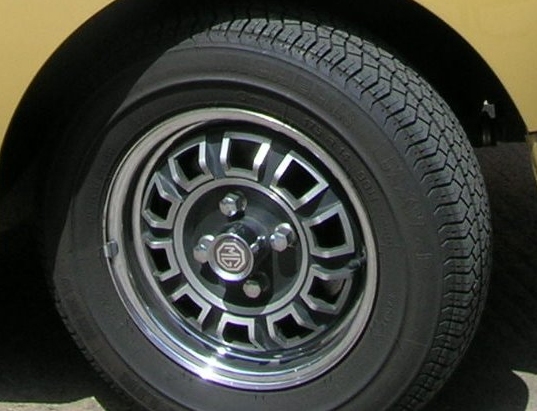
Dunlop composite wheels
The Dunlop composites have a distinctive cast alloy centre fitted to a chromed steel rim and remained unchanged throughout V8 production. They were a compromise between steel and alloy, providing a more robust rim than alloy but with a slight weight penalty. Great care is needed to avoid serious rust setting in on the rims, so regular cleaning and maintenance is vital.
Refurbishment is possible by a very few specialists, but is expensive. Occasionally a set of these wheels comes up for sale on the V8 website. So if you want to retain the originality with a set of Dunlop wheels, surely one of the key characteristics of the model, you need to make a careful check of the wheels for deep rust pitting on the rims when buying a factory V8 because badly pitted rims cannot be re-chromed properly. It is really only practical and safe to refurbish a Dunlop composite wheel once.
Electrical
The original headlights were Lucas sealed-beam with tungsten filament bulbs, but driving with them today on country roads feels only slightly better than sidelights. So most V8s now have replacement lenses fitted with halogen bulbs. The Lucas sealed-beams have convex glass lenses but only a few suppliers can now supply convex lens conversions. There is a useful V8NOTE on this from David Biddle. The metal bowls behind the headlights are prone to corrosion so check inside the front wing for this.
The V8 distributor with a contact set has to work hard and needs regular cleaning and setting, with replacement points at 6,000 mile intervals or less. One good feature is the external adjustor so the fine adjustment of the contacts can be made whilst the engine is running. Simply connect up a dwell meter and adjust to set the dwell to 28 degrees. For distributor maintenance, Holden Vintage & Classic offer an excellent rebuild service. Some parts (top plate for example) are the same as for the Range Rover which has been around since the early 1970s so are easy to obtain. Replacement contact sets and condensers are easily obtained, however most of them are of extremely poor quality, so it is best to buy only Lucas or Unipart spares.
Some members have fitted after-market electronic ignition systems. A comprehensive review of available systems from Gordon Hesketh-Jones, together with his interesting note on fitting a Pertronics unit with a powerful coil, are available on the V8 website.
One useful modification you will see is a 12 volt battery conversion on chrome bumpered cars to replace the original twin 6 volt arrangement. An 063, or even an 065 battery at a squeeze, can be used with the benefits of newer battery technology. But probably the most beneficial part of the conversion is to rid the car of the dreaded black tapered top hat battery connectors – surely the cause of more poor running and starting problems than anything else. Simply rejoice when they are replaced by good clamps or preferably the more convenient lever clamps. Again there are several comprehensive V8NOTES on 12v battery conversions.
Interior
The fine cord covered adjustable seats are distinctive but over time will need servicing with new seat foams and replacement cord covers. If you decide to do the job yourself, do remember to wear a pair of goggles when removing the clips on the seat webbing as they can fly about at speed and cause eye injuries.
The heater control valve fitted behind the air-box at the back of the engine is a regular source of trouble as it tends not to close properly allowing a flow of hot coolant to continue passing to the heater matrix toasting feet in warmer weather. Several V8NOTES explain how to overcome that fault.
Price guide
Prices depend very much on condition and to a lesser extent on model and colour. As a broad guide, Condition 1 cars range between £9,000 (CB) to £7,500 (RB), Condition 2 £6,500 (CB) and £5,500 (RB) and Condition 3 £3,500 (CB) and £3,000 (RB). A particular feature of the market over the last few years has been a growing interest in V8s from MG enthusiasts in Germany as the model now has “historic” status there with a lower annual road tax charge.
Conclusion
History is very important with a classic car and a V8 with a full history is getting harder to find. You will rarely see a V8 advertised with more than 125,000 miles recorded, yet these cars were often used as daily drivers for at least 10 years from new, and in some case for longer. So unless you have MOT certificates right back to the start, take the recorded mileage with a pinch of salt. A good set of maintenance records is also very useful so you know how well the car has been maintained and by whom and also you know what major work or replacements have been made. Many real V8 enthusiasts selling up want the car to go to a good home and will be proud of their maintenance and history file. That can be reassuring for a purchaser.
Today the V8 is seen as very much an MG combining the famous marque’s “safety fast” features – performance with predictable and forgiving handling characteristics. Spares availability is good as it shares many parts with the chrome and rubber bumper MGB models for which the specialist spares and service providers see an attractive market for stocking and resourcing a full range of parts. Good examples of both chrome and rubber bumper V8s are available at very reasonable prices, so it is likely the V8 will remain a sports car that a small band of enthusiasts will continue to enjoy and see as very good value today in every sense.
Photos: MGBGTV8 in a 1973 brochure (Publication 3037 from BL), memorable press advert (BL), Flamenco Red 2430 (Jeff Ward), the first rubber bumper V8 Teal Blue 2101 (BL calendar), bodywork rust photos (Billy Ashford, Dave Wellings & Gavin Bailey), V8 engine and Dunlop composite wheel (Victor Smith).

 MG Car Club
MG Car Club